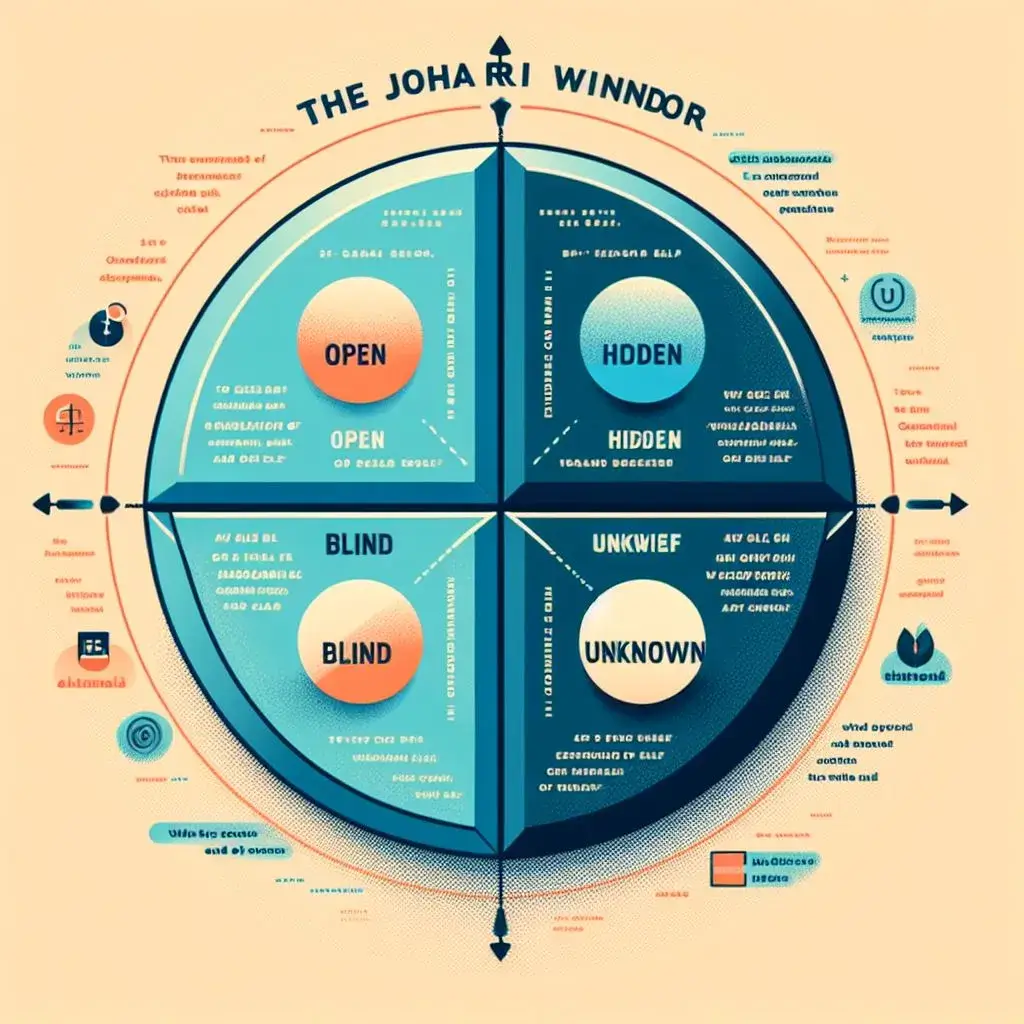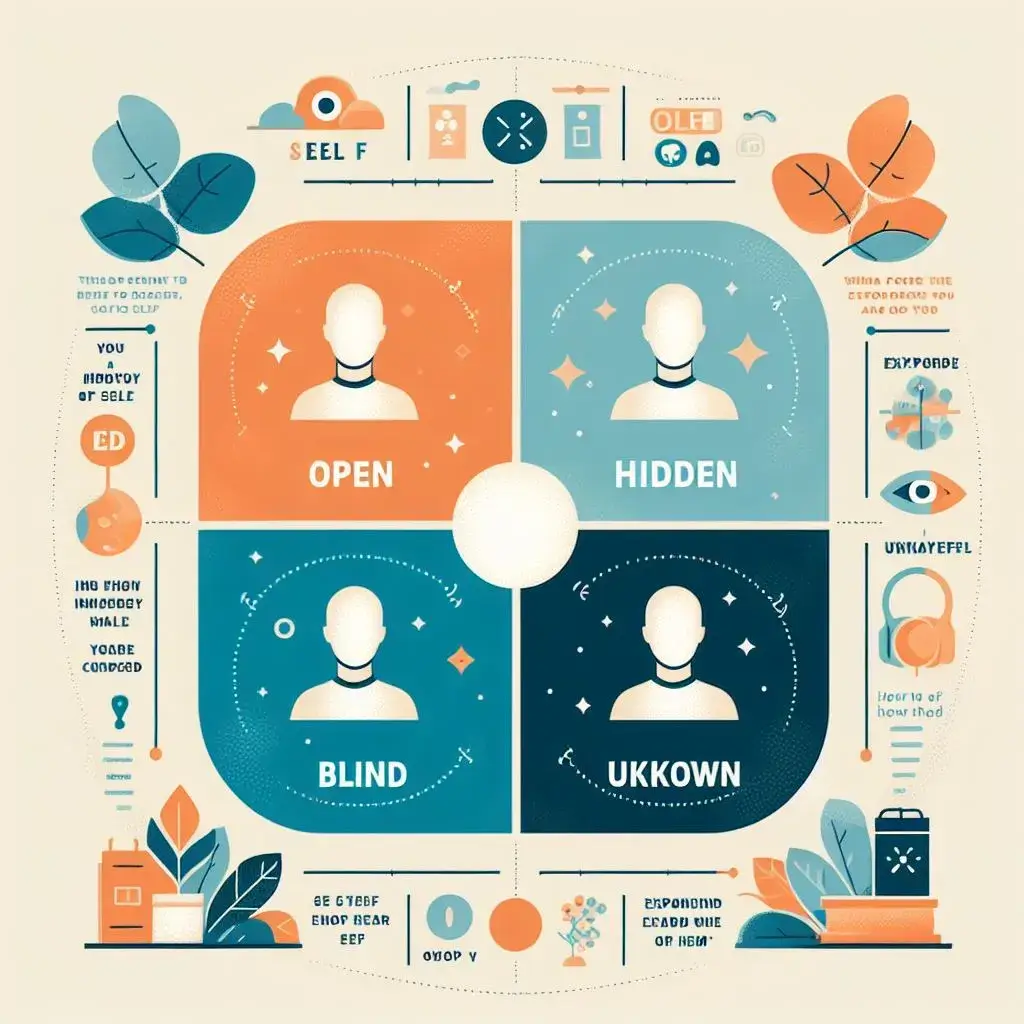Ever found something a bit fancy and weird-sounding? Well, the Johari Window, made by two dudes named Joseph and Harry, is way cooler than it sounds. It’s not just a weird idea; it’s like a super simple map they made to show all the layers of who we are. So, grab a snack, get cozy, and let’s embark on this journey together.
What is the Johari Window?
First things first, let me break down the Johari Window, The Johari Window is a psychological model developed by Joseph Luft and Harry Ingham in 1955. It is a tool used to improve communication and understanding between individuals in a group or team. The model is based on two fundamental concepts: self-awareness and feedback from others.
Luft and Ingham developed the Johari Window by asking individuals to identify adjectives that describe their own personality and then asking others to identify adjectives that describe the same individual. They then used this information to create a grid of adjectives that could be used to map out the different areas of an individual’s personality.
The Johari Window is divided into four quadrants, each representing a different aspect of an individual’s personality, Open Self (Public Self),Hidden Self (Private Self), Blind Self and Unknown Self. It’s like a window into your self-awareness and relationships!
Four Selves According to Johari Window

According to the johari window each person has four versions:
Open Self (Public Self)
The Open Self, also known as the Public Self, is one of the four quadrants of the Johari Window model. It’s the Instagram feed of your personality, where you display your interests, achievements, and everything you’re cool with people knowing. Imagine it as the front stage of a theater performance—well-lit, everyone can see what’s happening.
In this quadrant of Johari Window, we’re talking about the parts of you that you’re comfortable sharing. Basically, it’s the highlight reel of your awesomeness. This is where you consciously decide what to share with others, giving them a peek into who you are.
Building Interpersonal Connections: Now, let’s talk about making friends and connections. “The Open Self” is like throwing a big party and saying, “Come join my crew!” By sharing this part of yourself, you’re inviting others to get to know you better. It’s like having an open invite to a fan club where people can connect with you, sharing vibes and experiences.
Strengths and Positivity: The Open Self often shines a light on your strengths and positive attributes. It’s like showcasing your best self on a first date. You’re putting your best foot forward, letting people see the awesome side of you.
Creating a Social Identity: Think of “The Open Self” like creating your own brand, just like on social media but in real life. What you share here helps people form an idea of who you are. It’s like choosing what pictures to post online—each one adds to the story of your life. This part of you builds the foundation for meaningful relationships, like making friends who dig what you’re all about.
Hidden Self (Private Self)
The Hidden Self refers to the aspects of an individual’s personality that they know about, but choose not to reveal to others. This may include their thoughts, feelings, and experiences that they keep to themselves. The Hidden Self is also referred to as the Private Self or the Facade.
The Personal Diary of You: Think of your Hidden Self as a super-secret personal diary. It’s where you keep the stuff that’s just for you—your dreams, fears, and those quirky thoughts that pop into your head. This is like the backstage area of your life where not everyone gets a VIP pass.
Deeper Emotions and Insecurities: In the Hidden Self, you’re diving into the deep end of your emotions and insecurities. It’s where you keep the real talk about what makes you tick, the struggles you might not share with the world. This is like the private confessions you only tell your closest friends.
Blind Self
Imagine your life as a play, and the “Blind Self” is like the audience’s perspective—they see things about you that you might not be aware of. This quadrant of the Johari Window explores the aspects of yourself that are visible to others but remain hidden from your own view.
Mirror, Mirror on the Wall: The Blind Self is like looking in a magical mirror that reflects back things about you that you might not notice. It’s the external feedback and observations from those around you, providing a different angle on who you are.
Feedback from Others: In this quadrant, you’re tapping into what people say and notice about you. It’s like getting reviews on a performance. Others might see strengths, quirks, or habits that you might not be fully aware of, creating a mirror effect.
Unknown Self
The Unknown Self refers to the aspects of an individual’s personality that are unknown to both themselves and others. This may include their subconscious thoughts, feelings, and experiences that are not yet discovered. The Unknown Self is also referred to as the Subconscious Self or the Unknown Area.
The Hidden Potential: The Unknown Self is like a hidden treasure chest of untapped potential and undiscovered talents. It’s the part of you that holds surprises and unexplored possibilities, waiting to be unlocked. It’s the thrilling adventure of self-discovery.
Embracing the Mystery: In this quadrant, you’re diving into the mystery novel of your own life. It’s like leaving blank pages in your autobiography for the unexpected twists and turns. Embracing the Unknown Self means being open to surprises and growth.
How to Use the Johari Window Or How to deal with the four selves?
- Identify the four ‘selves’: The first step is to understand the four ‘selves’ represented by the Johari Window: the Open Self, the Blind Self, the Hidden Self, and the Unknown Self. The Open Self contains information that is known to both the individual and others. The Blind Self contains information that is known to others but not to the individual. The Hidden Self contains information that is known to the individual but not to others. The Unknown Self contains information that is unknown to both the individual and others.
- Assess your Open Self: Think about the information that you are willing to share with others. This can include your thoughts, feelings, experiences, and skills. Write down these items in the Open Self quadrant of the Johari Window.
- Solicit feedback from others: Ask trusted colleagues, friends, or family members to provide feedback on your behavior, communication style, and areas for improvement. This feedback can help you identify blind spots in your self-awareness and expand your Open Self.
- Disclose information to others: Consider sharing information about yourself that is currently in your Hidden Self. This can help you build deeper relationships with others and increase mutual understanding.
- Reflect on the feedback and your own self-awareness: Review the feedback you received from others and reflect on your own self-awareness. Identify any patterns or themes that emerge, and consider how you can use this information to improve your communication and relationships.
- Set goals and take action: Based on your reflection, set specific goals for improving your communication and relationships. This may involve practicing active listening, seeking feedback more regularly, or disclosing more information about yourself.
- Repeat the process: The Johari Window is a dynamic tool that can be used repeatedly to increase self-awareness and improve communication. Regularly assessing your Open Self, soliciting feedback, disclosing information, and reflecting on your self-awareness can help you continually grow and develop.
Benefits of Using the Johari Window
Here are some of the benefits of using the Johari Window:
Increased self-awareness:
The Johari Window can help individuals gain a better understanding of their own behavior, motivations, and communication style. By identifying the aspects of their personality that are known to themselves and others, individuals can develop a more accurate self-concept and increase their self-awareness.
Improved communication:
The Johari Window can help individuals identify areas where communication may be lacking or ineffective. By increasing the size of the open area, individuals can improve their communication skills and build stronger relationships with others.
Enhanced trust:
The Johari Window can be used to build trust between individuals by encouraging open and honest communication. By disclosing personal information and seeking feedback from others, individuals can demonstrate their trustworthiness and foster a more collaborative and supportive work environment.
Increased empathy:
The Johari Window can help individuals develop greater empathy and understanding for others. By recognizing the blind spots in their own behavior and seeking feedback from others, individuals can gain a better understanding of how their actions may be perceived by others.
Conflict resolution:
The Johari Window can be a useful tool for resolving conflicts and misunderstandings. By identifying areas of disagreement and seeking feedback from others, individuals can work together to find a mutually acceptable solution.
Career development:
The Johari Window can be used to identify areas for personal and professional growth. By recognizing the hidden areas of their personality, individuals can identify areas where they may need to improve their skills or seek additional training.
Team building:
The Johari Window can be used to build stronger teams by encouraging open communication and collaboration. By increasing the size of the open area, team members can develop a better understanding of each other’s strengths and weaknesses and work together more effectively.
Enhanced creativity:
The Johari Window can be used to stimulate creativity and innovation. By exploring the unknown areas of their personality, individuals can discover new ideas and perspectives that may lead to breakthroughs and innovations.


